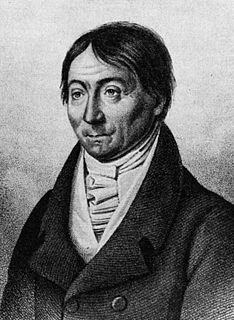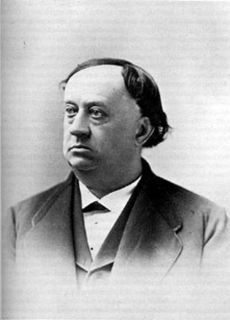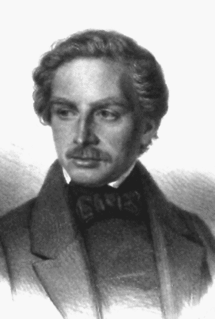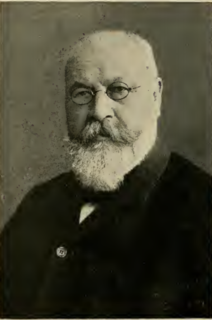
Johann Heinrich Friedrich Link was a German naturalist and botanist. The standard author abbreviation Link is used to indicate this person as the author when citing a botanical name.

Friedrich Hermann Loew was a German entomologist who specialised in the study of Diptera, an order of insects including flies, mosquitoes, gnats and midges. He described many world species and was the first specialist to work on the Diptera of the United States.

Hermann August Hagen was a German entomologist who specialised in Neuroptera and Odonata. He had established himself as one of Europe's preeminent entomologists by 1867 when he accepted a position at Harvard University to curate the Museum of Comparative Zoology. In 1870 he became the first entomologist in the United States to hold the formal title, Professor of Entomology.

Dr Wilhelm Ferdinand Erichson was a trained medical doctor and a German entomologist.

Johann Christoph Friedrich Klug, was a German entomologist. He described the butterflies and some other insects of Upper Egypt and Arabia in Christian Gottfried Ehrenberg and Wilhelm Friedrich Hemprich's Symbolæ Physicæ. He was professor of medicine and entomology in the University of Berlin where he curated the insect collections from 1810 to 1856. At the same time he directed the Botanic Garden in Berlin which contains his collections. Klug worked mainly on Hymenoptera and Coleoptera. The plant genus Klugia was named in his honour as well as the butterflies Geitoneura klugii and Heliophisma klugii.

Otto Staudinger was a German entomologist and a natural history dealer considered one of the largest in the world specialising in the collection and sale of insects to museums, scientific institutions, and individuals.

Carl Heinrich Georg(es) von Heyden was a German senator and entomologist. He collected insects in all orders but was especially interested in Coleoptera, Microlepidoptera, Hymenoptera, Diptera and fossil insects. His collections are divided between the German Entomological Institute and the Senckenberg Museum.

Friedrich Julius Schilsky (1848–1912) was a German entomologist. He was secretary of the Entomological Society of Berlin. His principal work was a catalogue of German beetles Systematisches Verzeichnis der Käfer Deutschlands, mit besonderer Berücksichtigung ihrer geographischen Verbreitung. Zugleich ein Käfer-Verzeichnis der Mark Brandenburg. In 1894, he continued Die Käfer Europas started by Heinrich Carl Küster (1807–1876), briefly succeeded by Ernst Gustav Kraatz (1831–1909) and Ernest August Hellmuth von Kiesenwetter (1820–1880). Schilsky, wrote the seventeen last volumes. His collections are in Museum für Naturkunde in Berlin.

Carl Heinrich Michael Ribbe was a German explorer and entomologist.
Hans Kotzsch was a German entomologist who specialised in Lepidoptera.
Hermann Wernicke (1851–1925) was a German entomologist.
Carl Wilhelm Louis (Ludwig) Grabow was a German entomologist especially interested in Coleoptera and Lepidoptera.
Karl Rost was a German entomologist and insect dealer. From 1886 Rost was an insect dealer (Insekten-Händler) and professional insect collector in Berlin. He collected insects later offered for sale in Spain and Greece. In 1899 he went on an expedition to Siberia and in 1900 -1901 collected in the Caucasus. In 1903 he went to Japan to collect insects for the Swiss collector George Meyer-Darcis after two years in North-West India. Rost described many new species from these regions. Parts of his personal collection are in the Museum für Naturkunde in Berlin and other parts are in the Zoologisch Museum Amsterdam. The rest were privately sold, many to the dealership Staudinger - Bang-Haas.
Richard Haensch was a German entomologist and insect dealer in Berlin.
Heinrich Friese was a German biologist and entomologist, specialist of bees (melittologist). Between 1883 and 1939 he described 1,989 new species and 564 new varieties or subspecies of insects, 99% of which were bees.
Emil Weiske was a German naturalist.

Theodor Alexander Otto Thieme was a German entomologist.

Rudolf Ludwig Meyer-Dür was a Swiss entomologist who specialised in Hemiptera, Orthoptera and Neuroptera He was a founder Member of the Swiss Entomological Society.
Hermann Stitz was a German biologist and entomologist. He was a specialist in Hymenoptera especially ants and Neuroptera. He worked mainly on the collections of the Berlin Museum für Naturkunde der Humboldt-Universität including insects collected on the German Central Africa Expedition 1910-11 and the German-Soviet Alay-Pamir Expedition of 1928











